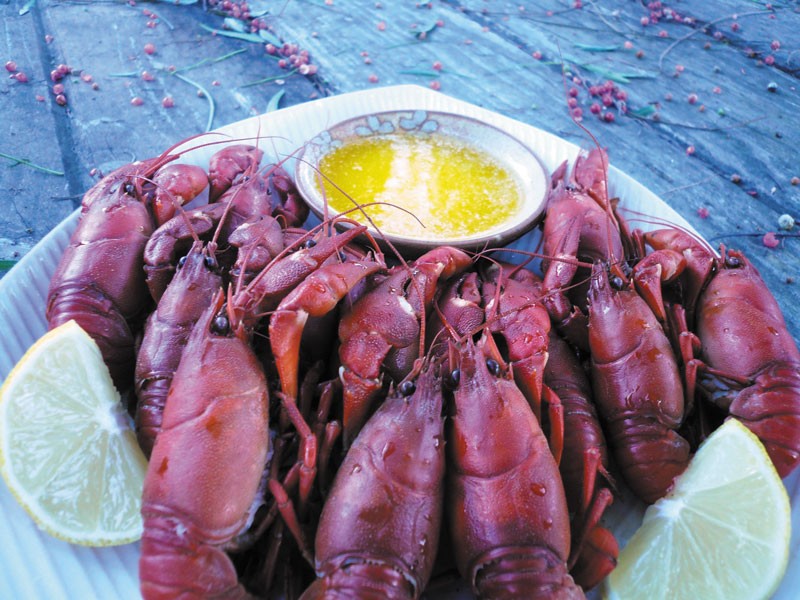Crayfish, mud bugs, swamp lobsters or crawdads — call them what you like; these little crustaceans are as delicious as they are abundant in freshwater along the North Coast. I look forward to every autumn and winter for the abundance of fungi, wild greens, shellfish, and yes, a seasonally strong and impressively sustainable sweet swamp lobster harvest. I headed to a local stream the other day and cast out two traps baited with the carcasses of fish I had caught a few weeks prior (minus the fillets that made some exceptional tacos). After a night of soaking I pulled in a haul of some 20 crayfish and cooked them up that night. If you're up for giving it a try, here's the scoop.
Catching a crawdad appetizer, lunch or dinner is easy and fun for all ages. I have been catching crayfish since I was about 3 years old and I enjoy a good haul now as much as I did then. Several crawdad species can be found throughout the world. Here in California, most waterways are inhabited by the native signal crayfish (Pacifastacus leniusculus) and the invasive Louisiana crayfish (Procambarus clarkii). As with any crustacean in the state, crawdad fishery is strictly regulated by the California Department of Fish and Wildlife. Methods of take, fishing hours, catch limits and guidelines for specific bodies of water can all be found in the complimentary CDFW Freshwater Sport Fishing booklet available online as a PDF or at any sporting goods store. If you want to buy a commercially made crawdad trap, local shops sell them for around $20. (I get mine at Bucksport.) If you are under 16 years of age, no license is required for taking crawdads, but if you are older you can buy one-day, five-day or annual fishing licenses at sporting goods stores or online (just don't forget to sign it or it's invalid).
If you are good with your hands, you may just want to purchase a few feet of ½-inch gauge wire mesh from the hardware store and make your own trap. Dozens of instructional videos on various trap designs can be found online and each style can be made in well under an hour (and for less than $5). Whether you choose to buy or make a trap, the next step is finding a productive fishing location.
You can fish all day, every day, over sterile sand bars and never catch a thing. But if you learn to read the underwater topography and habitat correctly, you can find a productive secret spot of your own, drop a trap and be in business. Crawdads prefer slow moving water with muddy banks interwoven with roots and rocks that provide secure nooks and crannies for hiding. Search the banks of rivers, creeks and lakes until you find shells of a few dead crayfish or even a few live ones moving in the water. Then locate a boulder or tree to serve as an anchor and toss in your baited traps. (Drop two or three in separate locations to increase chances of a hefty yield). It usually takes an hour for even the most ravenous mudbugs to make their way into the trap, so it is best to let them soak for some time. I prefer leaving them overnight, but if you follow this strategy make sure your lines are hidden so animal thieves will not be tempted to steal the bait — or worse the catch and the trap!
Once you have brought in your massive catch, it's time to put them to a bucket and rinse them with fresh water to ensure no silt or sediments adhering to a crawdad carapace ends up simmering in the cook pot. At this time, you will need to transfer them one by one from the trap (heavy neoprene gloves are a good idea), setting aside females visibly carrying eggs beneath their tails or juveniles that simply will not yield enough meat to make them worth retaining. Return these to the water to ensure sustainable future harvests. Now it's off to the kitchen with a bucket full of "bugs."
There is some debate among anglers as to the quickest and most humane way to dispatch a crustacean. These animals have no centralized nervous system, making them far from easy to kill. I have tried every method over the years and, regardless of the bad press it has received, dropping them into boiling water is by far the quickest. The body goes into instant shock and the crawdads die within about two seconds. Despite what you have heard in urban legends, they do not scream.
Once in the pot, let them boil for a few minutes with your favorite Creole seasoning (such as Zatarain's) until the shells change from a yellowish-brown to a deep red. The most meat will be found in the tail, and is delightful once you've cracked and de-veined the crayfish like you would a prawn. The claws of larger specimens may also contain a hefty morsel. Melt a little butter with garlic, slice some lemon and serve the wild-caught, locally harvested, sustainable and remarkably fresh crawdads to your friends and family. And while you enjoy the bounty, be sure to share every fish story that comes to mind — I always do.


Comments
Showing 1-1 of 1